What is compost, what is it made of and how is it composed? We reveal everything about the creation, use and spreading of compost in the garden.
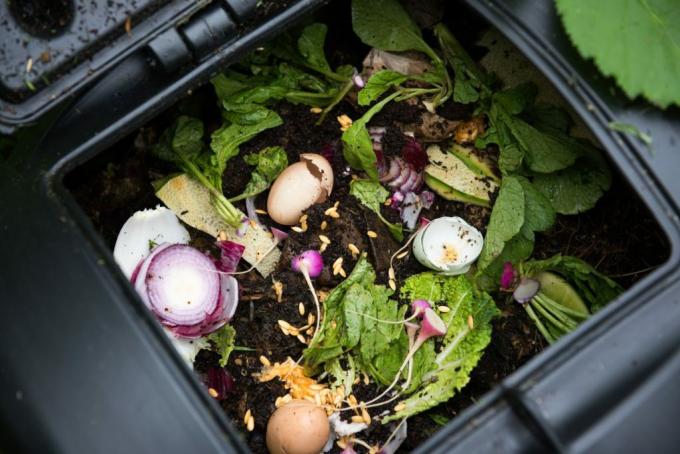
For centuries man has been compost from various refuse to fertilize his plants. Already in the 8th In the 19th century BC, the Greek poet Homer reported that a fragrant heap of dung was growing in Odysseus' farmyard, which was later spread over the fields. But which special and mysterious superpowers make compost so valuable for humans that it is sometimes referred to as the gardener's "black gold"? In this article you will learn more about the formation and origin, the properties and the application of compost.
contents
-
What is compost?
- What is compost made of?
-
properties of compost
- The rotting degree of compost
- Where does compost come from?
- Compost worms and other composters
- Compost from recycling centers
-
Make your own compost
- compost tea
- Spreading compost: How to use it properly
- compost in agriculture
What is compost?
Compost is dead organic material that has gone through the process of so-called rotting. Decomposition by air-breathing microorganisms first takes place in the composting process. These break down parts of the organic material in such a way that it escapes into the air in gaseous form as carbon dioxide. The starting materials slowly disintegrate into coarser parts and finally even into individual molecules or atoms. From these "building blocks" something new is then created in the process of "humification" - i.e. the formation of humus - namely the humic acids (or "humus molecules"). These, taken together and chemically combined with clay particles, form visible crumbs and flakes that we can recognize as compost or humus. You might be wondering now where exactly the differences between humus and compost - a very valid question. In fact, the word "compost" comes from the Latin composite, which roughly means "the compiled one". The name thus refers to the diverse starting materials that the composter - i.e. the human being - uses for the targeted formation of humus. So compost is a type of humus. Humus, on the other hand, is also created naturally and is therefore not to be equated with compost.
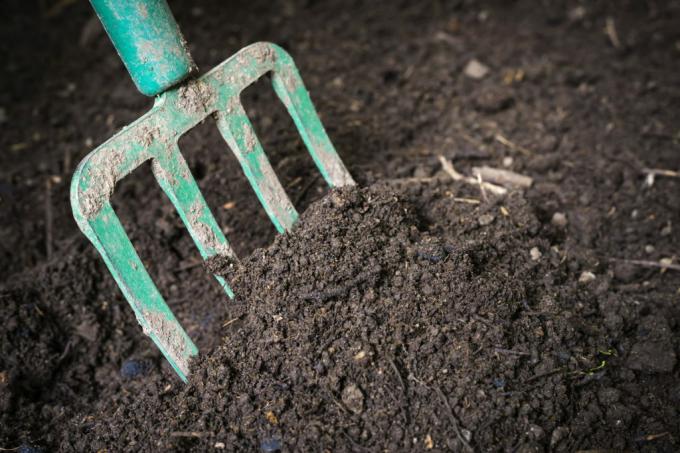
What is compost made of?
Like everything that has grown organically - i.e. animals, plants, fungi or even algae - compostable waste also consists of different proportions of carbon compounds. The cell walls of plants, for example, consist largely of cellulose, hemicellulose and pectin. All three are carbohydrates, i.e. carbon compounds that also carry oxygen and possess hydrogen appendages and are linked at the molecular level into long, stable chains are. When a cell wall is eaten and digested by microorganisms, the same thing actually happens as when we eat carbohydrates, for example in the form of a slice of bread: The carbon compounds contained are converted in cell respiration to generate energy and the end product is carbon Carbon Dioxide (CO2) exhaled with water.
Summary: What is compost?
- Compost is material that has rotted and turned into humus
- The term "compost" refers to the various man-made constituents of humus
- Compost consists of humus molecules which alone and in combination with clay particles form visible flakes
- During composting, carbon dioxide is released because microorganisms feed on the carbon compounds in the compost
properties of compost
In general, it can be said about compost that, depending on the degree of rotting, it is coarse and fibrous or brownish and crumbly and has a pleasant smell that is often perceived as “woody”. It is about twice as heavy as peat and half as heavy as sand. Compost also has many medium-sized pores, which allows it to improve aeration as well as water balance in the soil. Depending on the starting materials, it can be slightly acidic, neutral or slightly alkaline. The nutrient content depends on the raw materials and the duration of maturation: it can be very high or very low. Nitrogen, phosphorus and potassium - the three main nutrients of plants - can be in a balanced In relation to each other, the proportions of phosphorus and potassium are often high compared to the nitrogen elevated. Compost usually contains all the trace nutrients that plants need. The effect that compost fertilization has on the soil and the plants can also differ fundamentally: while a mature, low-nutrient green waste compost sustainably improves the soil properties by increasing the humus content, is a fresh, nutrient-rich Organic compost is better used for plant fertilization because it releases many nutrients but does not lead to an increase in the humus content in the soil Floor. If you are looking for the properties of compost as fertilizer If you are interested, you can find out more in this special article.
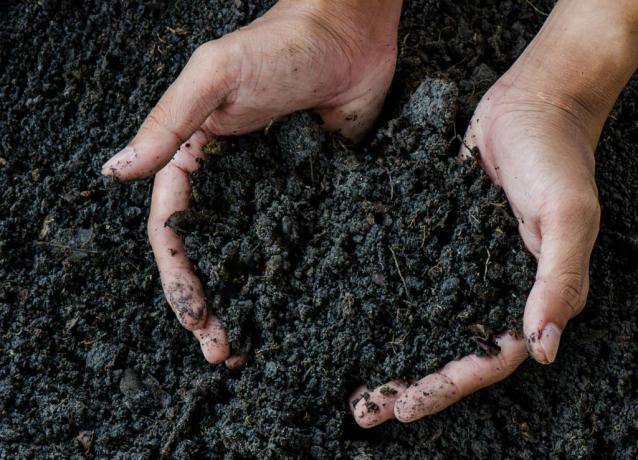
The rotting degree of compost
The rotting degree is the unit of measure in which the stability of compost against degradation by microorganisms is specified. Depending on the degree of rotting, decomposition takes place in the soil to varying degrees once compost has been spread. The stability increases as the degree of rotting and compost maturity increases, while the ability to release nutrients decreases at the same time. We find the reason for this in humification: Because this makes new, stable humus molecules from the organic building blocks released after decomposition, which are immune to degradation. Compost raw material has the lowest degree of decomposition, namely 1, fresh compost has a degree of decomposition of 2 or 3, finished compost has a degree of 4 or 5.
Summary properties of compost:
- The properties of compost depend on the starting materials and the degree of rotting
- Is coarse and fibrous, brownish-crumbly, or a mixture of both
- Pleasant, woody smell
- Heavier than peat and lighter than sand
- Has many medium-sized pores, which explains the good water and air balance in compost
- The pH is between 6.2 and 8.4
- Nutrient content from very low up to 50 percent by volume
- Contains a lot of phosphorus and potassium, usually less nitrogen, as well as trace nutrients
- Acts as a plant fertilizer or soil conditioner - or both
Where does compost come from?
As noted above, compost is a human-composed form of humus. Humus is also produced by the processes roughly described above at many natural sites where there is sufficient organic waste and microorganisms. A special rule of thumb applies here: If the living conditions for the microorganisms involved are tolerable, but not quite optimal, much more humus is produced than that nutrients are free will. And here we have an explanation for thick layers of humus in forests and bogs: In these locations it is Microorganisms are usually too acidic or too wet - there are also many other such humus-promoting Locations. Humification can also take place in your garden if you know a little about controlling humus-promoting conditions. In our special article you will find a lot of information on how to make your own garden floor humus economy Being able to make more humus step by step, even without applying humus.

Compost worms and other composters
You have probably already got the right impression that composting is by no means a purely mechanical or chemical process, but rather a biological process. This is carried out jointly by various members of the soil flora and fauna. Especially in the compost, the number of organisms per volume is incredibly high, because here you will find a real feast. In one cubic meter of compost there is a whopping 10 kilograms of living organisms! Groups involved are bacteria, fungi and other protozoa, roundworms (nematodes), insects and their larvae, mites, worms different genera, isopods, centipedes and snails. Depending on the prevailing living conditions, flora and fauna can be composed differently. The decomposition, humification, chemical change, mixing and degradation of organic pollutants are their tasks. Of course, they don't do this to please us: rather, they come to feed and reproduce when they find optimal living conditions. And this includes the presence of organic matter, sufficient moisture and oxygen, a slightly acidic or slightly alkaline pH value and temperatures that are as warm as possible. Once all the organic matter has been converted to humus, they die or migrate. If you want more about compost worms and want to read about worm composting, you can do so in our special article.
tip –Effective Microorganisms (EM): Various commercially available mixtures of widespread microorganisms (e.g. yeast fungi and bacteria) are referred to as EM, which are added to the compost when the Bokashi fermentation or to accelerate the necessary metabolic processes in sewage treatment plants. For use, the mixtures offered as a powder are mixed with a sugar solution and kept warm for a long time. After that, the microorganisms are called “activated” because they were able to grow in the sugar solution develop from the initial inactive permanent forms to active microorganisms and become strong multiply. They are then poured over the material to be processed with the sugar water. Unfortunately, the effect of using EM has not yet been proven, and there are still justified doubts as to whether the results observed were actually due to the microorganisms or not simply to the sugar solution are. For this reason, we cannot give a professionally justified recommendation for EM in composting.
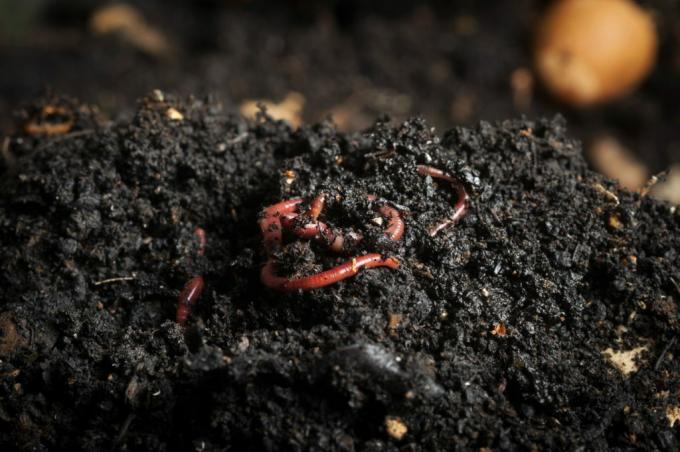
Compost from recycling centers
Compost that is sold at recycling centers is recycled from green waste and organic waste from the bio bin. Depending on the range, nutrient-poor and nutrient-rich materials are composted and sold together or individually. Green compost is poorer in nutrients, while organic compost is richer in nutrients. There are also various composting systems, some of which process huge amounts of compost. These range from traditional windrow composting to permanently implemented so-called “mobile windrows” to pressurized composting towers or drums with volumes of up to 1000 cubic meters, which constantly dynamically compost circulate. Of course, not every recycling center operates such a system - they are only used in areas where a lot of material needs to be processed quickly. You can read more about compost from the recycling or recycling center in this article, which deals with the fertilizing effect of compost deals. Also, if you want to know more about this Buying compost want to know, you can find everything you need to know in the corresponding special article.
tip – Hot and cold rot: If a lot of compost accumulates at once, as in recycling yards, a new heap, i.e. a compost heap, is set up in one go. The consequence of this is that the decomposition processes do not take place in layers (as in the home compost heap), but rather in all the material together. As a result of the life processes of the microorganisms, a lot of heat is generated. In addition, a large compost heap has its own insulation, which can result in core temperatures of 60 to 80 °C. Since this phase of intensive rotting lasts for several weeks, the entire volume can be strongly heated once by systematically moving it. This kills pathogens and weed seeds, so the compost becomes sterile. A private compost heap only reaches much lower temperatures due to the layered preparation and can therefore unfortunately carry seeds and pathogens of plant diseases.
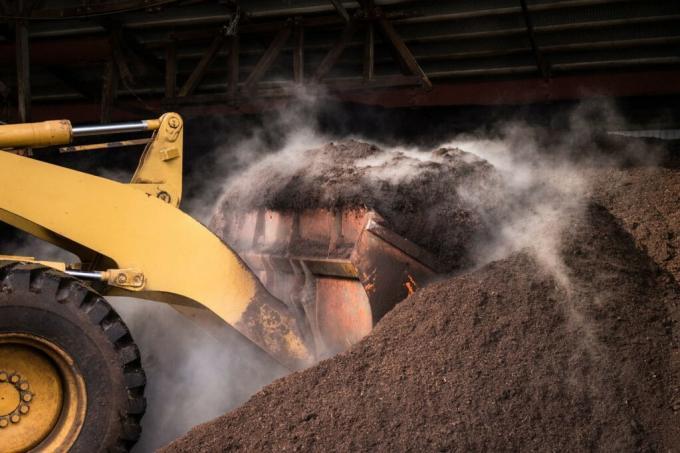
Make your own compost
Even without your intervention, humus is constantly being formed in nature. But you can take advantage of the underlying processes and even a quality one produce organic fertilizer or a soil improver and, by the way, your organic or residual waste bin relieve. We have summarized in a few keywords the steps you need to take to get your own compost. All the details you need to proper composting can also be found in this special article.
- Select a composter: compost heap, quick or thermal composter, roller composter or worm box.
- Find a suitable location: partially shaded, sheltered, in the garden on open and loose, healthy soil.
- Prepare the compost: pile up the compost; coarse, solid material alternates with soft, nutrient-rich material. Lime or nitrogen fertilizer may need to be sprinkled in.
- An occasional layer of finished compost or a pot of compost tea will have the same accelerating effect as using compost starters or compost accelerators.
- Either layer the compost very carefully or - if necessary and possible - turn it over once a year to achieve good mixing and aeration.
- Under the best conditions, fresh compost is ready after four to eight weeks and can be used as plant fertilizer. After at least six months you will have a finished compost that has both fertilizing and soil-improving properties. After two to three years you will receive mature compost, which has a soil-improving effect.
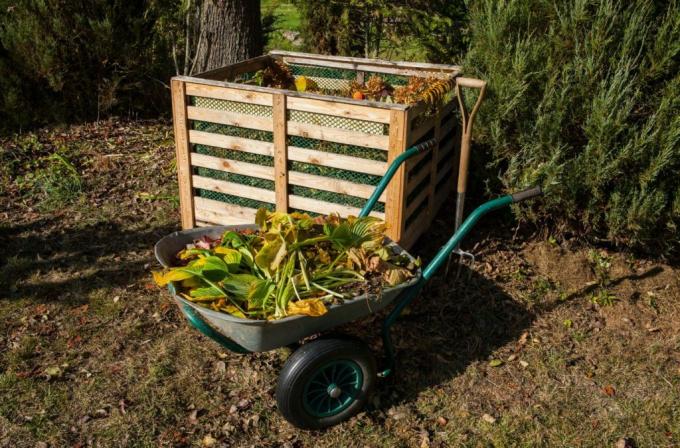
compost tea
Compost tea is prepared similarly to how the Effective Microorganisms (EM) mentioned above are activated. However, the source of the microorganisms is not a purchased mixture, but a few grams of compost. Sugar or syrup is mixed with compost in water and then left at 25°C for about a day. It is important to have a good supply of oxygen, which is ensured by blowing in air or by using a stirring system. After all, the microorganisms contained in the compost are supposed to multiply quickly in the broth. This can then be used to inoculate the soil or compost to promote biological activity. Spraying the plants with compost tea is also recommended in various internet forums, but the intended benefit for the plants is rarely or only very superficially mentioned. Microorganisms living in the soil cannot find a habitat on the plant and would not colonize it themselves, which is why a positive effect initially seems unlikely. Use as a compost starter and to increase microbial activity in planting areas at a However, simultaneous entry of organic matter (such as mulch) can have a positive effect to have. This applies in particular to newly prepared composts from very poor soils with low biological activity. It is questionable whether spreading the compost yourself would not have at least as great an effect.
Make your own compost tea:
- Pour 100 liters of rain or well water into a clean container (e.g. a rain barrel). If tap water is used, it must be left to stand for about seven days beforehand; stir occasionally
- Heat water to about 25°C with an immersion heater (100 to 150 W).
- Dissolve 500 g sugar beet syrup in the water, stir in 250 g rock flour, stir in 500 g compost or hang in a large-volume net
- Switch on the pond aerator pump (if possible with a bubbler).
- Leave for 12 to 18 hours, then drain, filter if necessary, with rain, well or stale water Dilute tap water (in the ratio 1:5 for soil treatment, 1:1 for compost treatment) and within four hours bring out
- Thoroughly clean the compost tea bin
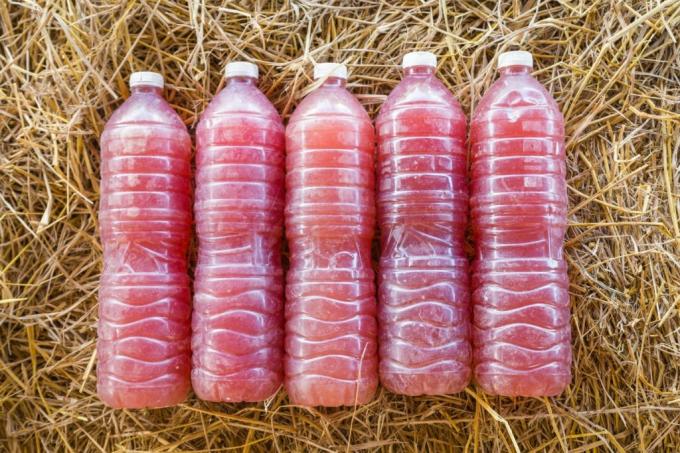
Tip: Since many of the described effects of compost tea and EM have not yet been definitively proven not many commercial companies in agriculture and waste management have yet adopted one of these methods. However, products for larger-scale manufacturing for companies are already on the market. It's more of an alternative approach so far, though, and we'd advise against relying on anything its proponents tout. In any case, over years of personal and scientific applications, spreading compost has been proven to improve the soil.
Summary: where does compost come from?
- Humus occurs in various natural locations to varying extents, it can also find its way into your garden in the form of potting soil - the best example of this is peat
- Compost is always created through the activity of countless, diverse microorganisms
- You can buy compost from recycling centers or produce it yourself on your own compost heap
- Effective microorganisms or compost teas are brewed to reproduce beneficial microorganisms and then diluted and applied to soil and compost. So far, however, the effect has hardly been defined or proven
Spreading compost: How to use it properly
Compost has many beneficial properties that improve soil and plant growth. When spreading, however, always bear in mind that compost is a collective term for various mixtures of different degrees of rotted and humified material and that its properties are accordingly not are constant. There are basically the following possible applications:
- Use of finished compost to fertilize plants and soil
- Mulch and fertilize with fresh compost
- Shallow application of finished or mature compost to improve beds
- Mix with soil or other additives to make your own potting soil
- Lawns and shrubs benefit when they are supplied with compost
Depending on the exact area of application, a different type of compost with different properties is optimal. For detailed advice on how to use compost, see this special article dedicated to the Fertilizing properties of compost occupied.
compost in agriculture
Compost can also be used in agriculture. The positive effect on soil health and yields has already been proven in various studies. One should really ask oneself why not much more of the "black gold" ends up on pastures and fields. Like any other fertilizer, it is subject to the Fertilizer Ordinance (DüV, supplement to the Fertilizer Ordinance DüMV). regulates which quantities are used at what time on which areas and for the cultivation of which crops to be allowed to.

Farmers, garden centers and also (fruit) tree nurseries have to keep records of their fertilization. In particular, the nitrogen inputs are precisely recorded and randomly checked. Agricultural operations determine the fertilizer requirement:
- The withdrawals due to harvested crops that have been picked up
- The nitrogen content in the soil
- The nitrogen replenishment by soil organic matter
- The subsequent delivery of nitrogen from crop residues from previous crops
- The nitrogen supply from previous green manures
- The nitrogen replenishment from organic fertilizers in the previous three years
This list is compared with the nutrient requirements of the crop and further fertilization is adjusted accordingly. Nitrogen inputs and nitrogen withdrawals are offset against each other annually in the "nutrient comparison". and should balance each other out as far as possible or at least not exceed specified limit values.
In the newly drafted Fertilizer Ordinance of 2017, composts are treated as follows: in the first year after application 4% of the total nitrogen content is taken into account when determining the fertilizer requirement, in the second and third year only 3 each %. This results in the released nutrients that should be available to the crop plants. In the nutrient comparison, however, 100% of the nitrogen content over the three years is taken into account. Adequate supply of the plants with compost would therefore only be possible if the limit values applicable in the comparison of nutrients were also exceeded. However, anyone who exceeds these limits must expect penalties. This inconsistency in the Fertilizer Ordinance complicates the use of compost in agriculture and is currently regulated by an individual agreement with the fertilizer authority, but hopefully soon dissolved.
Summary of compost in agriculture:
- Fertilizing with compost has been shown to have many positive effects on soil health and yield
- Compost is currently very difficult to calculate when determining fertilizer requirements and comparing nutrients
- This currently complicates the use of compost in agriculture
As you can see, compost has many benefits. With a few more ingredients, you can also make your own Mix your own compost. In our special article you will find instructions on how to mix compost-based potting soil yourself.

